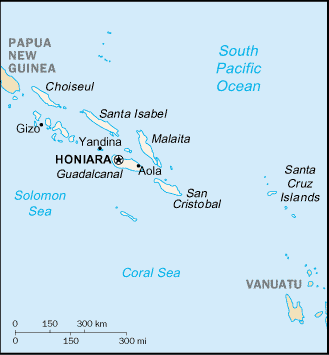Persecuted church list...
Map:

Overview:
The UK established a protectorate over the Solomon Islands in the 1890s. Some of the bitterest fighting of World War II occurred on these islands. Self-government was achieved in 1976 and independence two years later. Ethnic violence, government malfeasance, and endemic crime have undermined stability and civil society. In June 2003, Prime Minister Sir Allen KEMAKEZA sought the assistance of Australia in reestablishing law and order; the following month, an Australian-led multinational force arrived to restore peace and disarm ethnic militias. The Regional Assistance Mission to the Solomon Islands (RAMSI) has been very effective in restoring law and order and rebuilding government institutions.
The People:
Population: 538,032 (July 2005 est.)
Age structure:
0-14 years: 41.9% (male 114,860/female 110,404)
15-64 years: 54.9% (male 149,400/female 145,970)
65 years and over: 3.2% (male 8,371/female 9,027) (2005 est.)
Religions:
Church of Melanesia 32.8%, Roman Catholic 19%, South Seas Evangelical 17%, Seventh-Day Adventist 11.2%, United Church 10.3%, Christian Fellowship Church 2.4%, other Christian 4.4%, other 2.4%, unspecified 0.3%, none 0.2% (1999 census)
Government Type:
parliamentary democracy
Leader(s) to pray for:
chief of state: Queen ELIZABETH II (since 6 February 1952), represented by Governor General Nathaniel WAENA (since 7 July 2004)
head of government: Prime Minister Sir Allan KEMAKEZA (since 17 December 2001); Deputy Prime Minister Snyder RINI (since 17 December 2001)
Source: The World Factbook
View All Countries